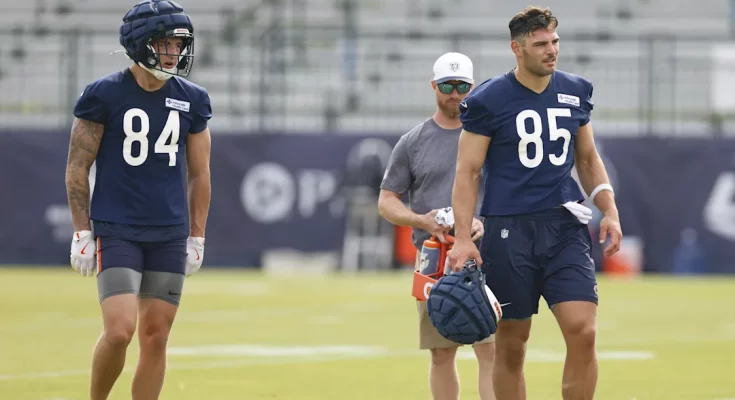Cole Kmet has never been the kind of player to run from competition. From the moment he arrived in the NFL, he’s embraced every challenge that’s come his way with the quiet confidence of someone who knows his worth. So when the Chicago Bears used a first-round pick on Michigan’s standout tight end Colston Loveland, there was no panic in Kmet’s demeanor. No hint of frustration. No passive-aggressive quotes. Just a steady reaffirmation of the fact that he’s here to compete, he’s here to lead, and most of all, he’s here to win.
That veteran composure has stood out during Bears training camp, as onlookers, reporters, and fans try to decipher the dynamics of a potential tight end transition in Chicago. Loveland arrives with sky-high expectations, hailed as one of the most athletic and versatile tight end prospects in recent memory. The rookie is long, explosive, and dangerous after the catch—traits that perfectly align with what Ben Johnson wants in a pass-catching weapon. But despite the glitz of new talent and the buzz surrounding Loveland, it’s Kmet who remains the emotional heartbeat of the tight end room. And he’s made it clear—without saying much—that he’s not going anywhere quietly.
Throughout camp, the competition has been evident. Loveland has flashed early, especially in red zone work, where his large catch radius and deceptive footwork have given defenders trouble. He’s already built a noticeable rapport with Caleb Williams, and his ability to shift between in-line tight end and big slot roles adds layers to the Bears’ offensive possibilities. But Kmet, who signed a four-year extension just a season ago, hasn’t faded into the background. Instead, he’s doubled down on his preparation, sharpened his route-running, and proven yet again why he’s one of the most reliable options in the league.
Kmet’s game isn’t as flashy as Loveland’s. He’s not going to leap over defenders or break off 40-yard gains with regularity. What he will do, however, is line up in the right spot every time, pick up the blitz, seal the edge on outside zone runs, and catch everything thrown his way on third-and-medium. He’s a throwback tight end with modern polish—someone who can do a bit of everything and rarely makes mental mistakes. And in a league that often obsesses over upside, the Bears coaching staff is showing signs they understand the value of consistency.
Teammates have noticed Kmet’s quiet fire. During one particularly intense practice, Kmet caught three passes in a span of four plays, each one punctuated with subtle gestures that seemed to say, “I’m still that guy.” It wasn’t boastful. It was deliberate—a reminder to everyone watching that while Loveland might represent the future, the present still belongs to No. 85. Williams has appreciated having a steady veteran option in the huddle, often leaning on Kmet in high-pressure situations during scrimmages. The rookie quarterback even noted in a media session that Kmet’s leadership has helped him settle into the pro game more quickly than he expected.
The dynamic between Kmet and Loveland is not antagonistic, either. It’s competitive, but it’s layered with mutual respect. Kmet has praised Loveland’s intelligence and work ethic, while also making it clear that he won’t be handing over snaps without a fight. Loveland, to his credit, has avoided the arrogance that sometimes accompanies top-tier draft picks. He’s spoken openly about learning from Kmet, watching how the veteran handles meetings, walkthroughs, and in-game adjustments. This isn’t a feud—it’s a football evolution. And both players are making each other better.
Ben Johnson has a challenge on his hands, but it’s a good one. In today’s NFL, having two tight ends who can play starter-level snaps is not a problem—it’s an advantage. Johnson comes from a system in Detroit that saw immense success deploying multiple tight end sets, using them to manipulate matchups and create openings for playmakers. With Kmet and Loveland, the Bears now have the versatility to play both heavy and spread packages without substituting. It opens up their playbook, gives Williams more options, and forces defenses to account for both tight ends at all times.
Still, make no mistake—there’s pride on the line here. Kmet isn’t just playing to be part of a committee. He’s playing to prove that his spot at the top of the depth chart hasn’t been lost. His blocking in particular has been standout during camp, often setting the tone during full-contact periods. In a league where so many tight ends shy away from the gritty part of the position, Kmet relishes it. It’s that physicality, paired with his dependability in the passing game, that gives him such value to an offense trying to build around a young quarterback.
Loveland, for all his promise, is still learning the nuances of the position at the pro level. He’s had moments where the game looks too fast, especially when lined up against veteran linebackers or disguised coverages. But those growing pains are expected. What matters is that the rookie keeps bouncing back, keeps asking questions, and keeps showing up in the film room. Coaches are impressed with how coachable he is, and they believe his ceiling is sky-high. Still, Kmet isn’t going to make it easy for him to ascend the ladder. And that’s exactly how it should be.
Veteran tight ends often get overlooked once a team drafts their successor. But Kmet is not your average placeholder. He’s a homegrown product, a former Notre Dame standout, and a guy who’s poured everything into becoming a cornerstone of this franchise. The Bears didn’t extend him last year because they felt obligated—they did it because he earned it. And as Loveland begins his own journey, he’ll do so with a front-row view of what it means to grind, to lead, and to last.
Bears fans, for their part, are divided. Some are eager to see Loveland unleashed, especially after years of offensive inconsistency. Others remain firmly in Kmet’s corner, valuing the toughness and trust he brings to the offense. But the best-case scenario isn’t one or the other—it’s both. Imagine a Bears offense where Loveland stretches the seam and draws safeties, while Kmet chips the edge and releases into the flat for a first down. Imagine a red zone alignment where the defense has to guess which tight end is the primary target. That’s the vision, and it’s a compelling one.
Of course, visions have to be executed. And execution will depend on who seizes the moment when it matters most. The preseason will provide glimpses. So will joint practices. But the real proving ground will be Sundays in the fall, when bodies fly, windows tighten, and trust becomes currency. In those moments, veteran presence counts. Kmet has already built that trust, and he doesn’t intend to let it erode.
If anything, the arrival of Loveland has reignited a fire in Kmet. Not a fear of being replaced, but a renewed sense of purpose. He’s more locked in. More vocal. More committed to dominating the small details. This is what true competition does—it elevates everyone. And for a Bears team trying to climb out of the NFC basement and into relevance, that internal sharpening might be more valuable than any external addition.
So don’t mistake Kmet’s calm for complacency. Don’t read his praise for Loveland as surrender. And don’t assume that a rookie’s arrival signals the end of a veteran’s era. Because Cole Kmet is still here. He’s still fighting. And he’s still proving, day by day, that the Bears’ tight end room might be crowded—but it’s his name that sets the tone.



